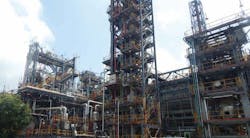NRL lets contract for new units at Numaligarh refinery
Numaligarh Refinery Ltd. (NRL) has let a contract to Axens Group of France to deliver technology licensing for a series of new units in the gasoline-production block to be built as part of the long-planned expansion of its 3 million-tonnes/year Numaligarh refinery in the Brahmaputra valley of Assam’s Golaghat district, in far-northeastern India (OGJ Online, Jan. 16, 2019; Aug. 13, 2014).
As part of the Feb. 16 agreement, Axens will license its proprietary technologies for a naphtha hydrotreating unit, Octanizing continuous catalyst regeneration (CCR) reforming unit, C5-C6 isomerization unit, and Prime-G+ FCC gasoline selective desulfurization unit, the service provider said.
Alongside delivering technology licensing, Axens will also supply the basic engineering design package, catalysts, adsorbents, proprietary equipment, training, and technical services for the project.
A value of the contract was not disclosed.
This latest contract for the refinery’s expansion follows NRL’s recent respective awards to Lummus Technology LLC and Chevron Lummus Global LLC—a partnership of Chevron USA Inc. and Lummus Technology—to provide technology licensing, basic engineering, and additional services for a new Indmax petrochemical fluidized catalytic cracking (PFCC) unit and LC-FINING ebullating-bed residue hydrocracking platform—including an integrated vacuum gas oil hydrotreater—to be added as part of the project (OGJ Online, Feb. 9, 2021; Feb. 4, 2021).
Expansion overview
Part of the government of India’s Hydrocarbon Vision 2030 initiative to help meet growing demand of petroleum products in northeastern India, NRL’s refinery expansion—which will increase overall crude oil processing capacity at Numaligarh by 6 million tpy to 9 million tpy—is scheduled to be completed by 2024.
Officially approved by India’s Cabinet Committee on Economic Affairs in January 2019, the originally planned 225.94 billion-rupee Numaligarh expansion—which also will include construction of a 180,750-b/d, 1,398-km crude pipeline from Paradip to Numaligarh, as well as a 120,500-b/d, 654-km products pipeline from Numaligarh to Siliguri—subsequently required an additional investment of 41.65 billion rupees to complete for a revised overall project cost of 267.59 billion rupees, according to NRL.
According to a February 2020 environmental impact assessment for the refinery’s expansion completed by Engineers India Ltd. (EIL), the project—which will involve construction of a new refining unit at the site designed to process imported sour crudes—will add the following major units and capacities at Numaligarh:
- Combined crude-vacuum distillation unit (with naphtha stabilizer); 6 million tpy.
- Naphtha hydrotreating unit; 1.2 million tpy.
- CCR unit; 750,000 tpy.
- Naphtha isomerization unit; 500,000 tpy.
- PFCC unit; 1.95 million tpy.
- FCC gasoline hydrotreating (desulfurization) unit; 580,000 tpy.
- Diesel hydrotreating unit; 3.55 million tpy.
- Hydrogen generation unit; 95,000 tpy.
- Residue upgrading unit (ebulated bed, with vacuum gas oil hydrotreater); 2 million tpy.
- LPG treating unit; unavailable.
- Fuel gas treating unit; unavailable.
- Sour-water stripping unit; unavailable.
- Amine regeneration unit; unavailable.
- Sulfur recovery unit, tail-gas treatment unit; 230,000 tpy each.
The project additionally will involve a revamp of the refinery’s existing 300,000-tpy delayed coking unit to increase its processing capacity to 570,000 tpy, according to EIL.
NRL’s owners include Bharat Petroleum Corp. Ltd. (61.65%), Oil India Ltd. (26%), and the government of Assam (12.35%).
About the Author
Robert Brelsford
Downstream Editor
Robert Brelsford joined Oil & Gas Journal in October 2013 as downstream technology editor after 8 years as a crude oil price and news reporter on spot crude transactions at the US Gulf Coast, West Coast, Canadian, and Latin American markets. He holds a BA (2000) in English from Rice University and an MS (2003) in education and social policy from Northwestern University.

